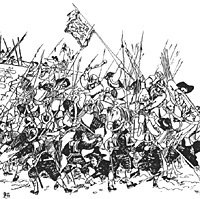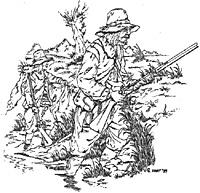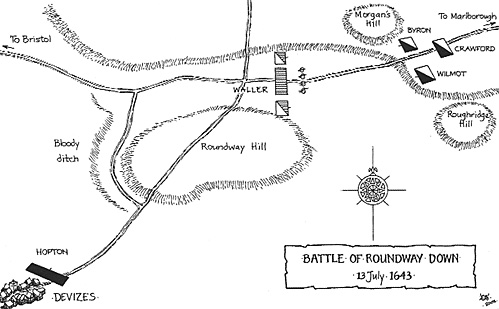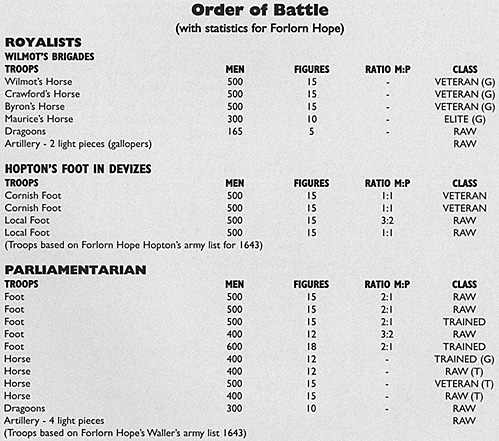 Although the Royalists were the clear victors at Lansdown (beating Sir WiIliam Waller on the 5th July) their casualties were so high that they were unable to follow up their success, allowing instead Waller to fight another day.
Although the Royalists were the clear victors at Lansdown (beating Sir WiIliam Waller on the 5th July) their casualties were so high that they were unable to follow up their success, allowing instead Waller to fight another day.
To make matters worse for the Royalists, Sir Ralph Hopton, their commander, was injured when an ammunition cart exploded, causing him severe burns and rendering him temporarily blind. Waller, hearing of this incident, chose to take advantage of it. He immediately dispatched a runner to Bristol and was sent fresh troops with which to take the offensive once more.
By the 9th of July, Hopton had entered Devizes and soon learned of Waller's march towards him. In order to slow Parliamentarian progress the Royalists sent out some of their horse, under Colonel Neill of Caernarvon, but after a brief struggle Caernarvon's cavalry were pushed back in to the town. Waller continued his advance and on the 10th drew up the entire army on Roundway Down. He now awaited the Royalists to follow suit.
When it became clear that Hopton would not offer battle, Waller ordered his army off the high ground and into the valley below, effectively laying siege to the town. The Royalists now held a council of war, in which it was decided that the cavalry break out and head to Oxford, where reinforcements could be gathered. The cavalry soon afterwards left the town without a hitch, arrriving in Oxford on the morning of the 11th.
The following day Waller's artillery, on the high ground, began a sustained bombardment of the town, which, it was said, continued by day and night. The Royalists could hardly reply, for there was little in the way of powder nor shot. A house to house search was made for bed cords, with which to make match. Guttering was torn from buildings and melted down for bullets.
Waller continued to pour shot in to the town, and so confident of victory he offered the Royalists surrender terms. Hopton, buying for time, agreed to talks and spun them out for many hours, knowing that relief would soon be on its way. Fortunately Royalist horse, under Lord Wilmot, with 1,800 men and 2 cannon, had already begun its advance from Oxford and were by now less than twelve miles away at Marlborough.
When Wilmot's horse approached Roundway Down, they fired two cannon shots, a pre-designated signal to Hopton in the town. The plan was for the Royalists to sally out and attack Waller when the signal was given, whilst Wilmot struck the Parliamentarians from the rear. The Parliamentarians would be caught in a devastating pincer movement from which they would never recover.
The Parliamentarians were in a perilous position, to their front lay 3,000 foot in Devizes and 1,800 horse, fast approaching, to their rear between Morgan's Hill and Roughridge Hill. Waller, with 2,500 foot and 2,000 horse, still outnumbered the Royalists if he took them on individually. He now set about preventing them from combining. Little did Waller know, nor come to that did Wilmot know, that the Royalists in Devizes had refused to sally out of the town fearing that all that was seen might be but a stratagem of Sir William Wallers to get the forces out of the town: Until the Devizes garrison could confirm that the cavalry now approaching from the northeast were Wilmot's Horse from Oxford, they would stay put.
Fortunately for Waller a scout informed him of the approach of the Royalist horse from the northeast. Immediately the Parliamentarians lifted the siege and repositioned themselves back on the high ground of Roundway Down. Here Waller drew his army up with his foot in the centre, behind his artillery, with the horse, Hesilrige's Lobsters on the right and Waller's horse on the left.
 Wilmot, still expecting to be joined by the foot from Devizes deployed to meet Waller's army. Wilmot's Horse were on the right and Lord John Byron's Horse on the left. To the rear, acting as reserve, stood the Earl of Crawford's Horse.
Wilmot, still expecting to be joined by the foot from Devizes deployed to meet Waller's army. Wilmot's Horse were on the right and Lord John Byron's Horse on the left. To the rear, acting as reserve, stood the Earl of Crawford's Horse.
Battle was soon joined when the Royalist forlorn hope pressed forward and engaged the Parliamentarians, who it seems quickly lost heart and fll back, disordering their main body of foot. Byron, itching to get into the fight, ordered the charge and led his men forward to the Parliamentarian lines.
Hesilrige, rising to the challenge, advanced to meet them. When the clash came, the parliamentarians immediately began to get the worst of it, for Hesilrige's cavalry were in close order, allowing Byron's horse to overlap on each flank. Hesilrige's men turned and fled the field, leaving the Parliamentarian right flank perilously exposed
Wilmot's cavalry pressed forward towards the Parliamentarian left, overran their guns, and charged in to Waller's Horse, who, although uphill, stood desperately trying to break up the charge with carbine and pistol fire. The melee was brief but bloody, much violence occurring on both sides. Again however the Parliamentarians were forced back. Directly behind them their reserves, standing too close, had little chance to manoeuvre out of the way and so were disordered by Waller's cavalry as they attempted to turn and flee.
Unfortunately the route which many of the Parliamentarians chose to retreat took them to a steep escarpment, which many fell victim to, horse and rider alike plunging over, breaking their necks. Those that were fortunate enough to escape this fate did not stop till reaching Bristol. The Parliamentarian foot, as in many battles, were left to fend for themselves.
Waller now formed his foot into two bodies and surprisingly carried on a stubborn resistance under his direct command. The Royalists in Devizes, seeing that the fight on the Downs was not a trick, formed up and filed out of the town, although by now they were hardly needed.
The Parliamentarian foot now attempted to withdraw in good order as they were now coming under direct fire from two of their own captured guns. Seeing all was lost many now began to fall out of rank and flee to the west. Those who stuck together fired off the last of their powder and laid down their arms. Those that had chosen flight were pursued and cut down on the moors. Waller's army of 4,500 men now ceased to exist, the Royalists claiming to have killed over 600 of them and captured 800.
THE GAME
An interesting game where the Parliamentarian player has the difficulty of fighting on two fronts. The main battle is an all arms v horse struggle, so should prove pretty fast flowing. As the Royalists in Devizes initially refuse to sally from the town, (and who can blame them after the horrendous casualties they suffered at Lansdown) they should only be allowed to advance on the roll of a six after Wilmot's brigade have actually started the engagement.
The Royalist aim is to destroy Waller's army, whilst the Parliamentarian victory comes if they defeat Wilmot's brigade before Hopton's foot is actively engaged in battle, for the Royalists will immediately retire back in to the town seeing their cavalry defeated. (For gaming purposes it will be reasonable to assume only four bodies of troops, 2,000 men, will sally out of the town.)
TERRAIN
There are three main areas on the board:
- Top right are the two hills, Morgan's Hill and Roughridge Hill, with a road running between them (entrance area of Wilmot's Brigade).
- Roundway Down, a high area of land which should dominate the centre of the board. A road runs through it which goes to Devizes. The Downs should be slightly undulating, but not too excessive as to impede too much movement.
- Directly to the west of the Downs the steep escarpment, `Bloody Ditch' is located. It is impassable to all troops. The town of Devizes needs to be placed at the bottom edge of the table with a flat area of land, the valley, between it and the Downs.
MAP and OOB


Back to Battlefields Vol. 2 Issue 1 Table of Contents
Back to Battlefields List of Issues
Back to Master Magazine List
© Copyright 2004 by Partizan Press.
This article appears in MagWeb.com (Magazine Web) on the Internet World Wide Web.
Other articles from military history and related magazines are available at http://www.magweb.com